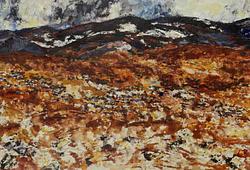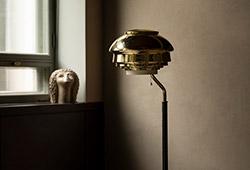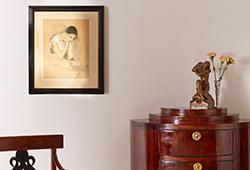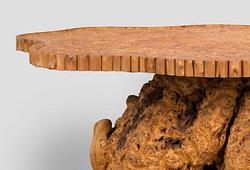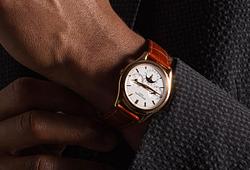Several works by Erik Olson at Modern Art + Design
Erik Olson Fiskare vid Seine (Fisher men by Seine)
Erik Olson and his cousin Waldemar Lorentzon arrived in Paris at the start of 1924. There they came to be included within the very first circle of students at what was then the most modern art school on the continent: Fernand Léger’s Académie Moderne in Montparnasse. In Paris, Erik spent a lot of time with his close friend the artist Otto Carlsund. Together they visited Amédée Ozenfant’s ultra-modern studio designed by the architect Le Corbusier.
The visit made a huge impression on Erik who wrote to Egon Östlund that: “it is a studio that is, in its Puristic simplicity and clarity when it comes to its architecture, unparalleled”. Erik found the same clarity in Ozenfant’s painting, which he described as “extremely simplified forms that play, together and apart, and are accompanied by entirely musical colours…” Later Erik also ended up visiting Piet Mondrian’s studio and was amazed not only at how he painted in right angles but that each item and tool in his studio were perfectly aligned too, and that even the artist himself stood with one of his arms at an angle.
On the 29th of March 1928 Erik wrote (to Egon):
“Lately I have been heavily invested in new ideas and am now working on two things… The paintings are almost neo-plastic in style – straight lines, reduced curves and a few circles in a couple of simple colours – sharply and precisely worked. Composition I and II, also called Fiskare vid Seine and Grå figur”. This version of Fiskare vid Seine (1928) is owned by Gothenburg Museum of Art.
In the auction’s Fiskare vid Seine, Erik Olson plays with so-called ‘impossible figures’. By shifting the different surface planes he invokes a sense of depth, at the same time as retaining a flat surface. The shapes and the figures in the painting are constantly changing place, which gives the viewer a feeling of simultaneously experiencing space and architectural surface.
To the artwork

Erik Olson Carré Rouge
“This April Erik [Olson] and Franciska Clausen will be exhibiting together with ‘Cercle et Carré’, an international group in Paris who wanted to work with the two geometric forms of the circle and the square. After the horrendous devastation of the First World War, they went in search of reality with reliable values and found it in geometric forms. Included in this group were, for example, Mondrian, Sonia Delaunay, Pevsner, Ozenfant, Sophie Täuber-Arp and Vantongerloo. Erik will be participating with three paintings, including Fönstret and Röd kvadrat (Carré Rouge), reproduced in the group’s magazine of the same name. This group quickly dispersed and in 1931 continued as ‘Abstraction-Création’.
The Concretists defined geometric forms as concrete (a circle only depicts a circle etc.). They did not abstract a fragment of reality but rather “made concrete” an artistic idea.” (From the exhibition catalogue for Erik Olson – en sökares drömmar och visioner, 2011, pp. 69-70.
The painting in the auction Carré Rouge was executed in 1930. Its provenance is silversmith Wiwen Nilsson, who was a good friend of Erik Olson and of the other members of Halmstadgruppen. During the summer of 1930 Olson and his wife Solveig lived with their friend Wiwen in Lund, and their daughter Viveka was born there on the 11th of July.
Carré Rouge was also included in the now legendary ‘Art Concret’ exhibition shown at Café Puck during the 1930 Stockholm Exhibition (19th of August to 29th September 1930). Gunnar Asplund, the chief architect of the Stockholm Exhibition, had commissioned Otto G Carlsund to put the show together. Carlsund loaned 107 artworks from 31 international and Swedish artists. These were shown on a 23-metre long wall of one of the exhibition area’s restaurants, Café Puck, and included several artists from the ‘Art Concret’ movement.
To the artwork

View more works to be sold at the auction
The works will be sold at Modern Art + Design
Viewing 5 – 9 May, Berzelii Park 1, Stockholm.
Open Mon–Fri 11am–6pm, Sat–Sun 11am–5pm.
Auction 10 – 11 May, Arsenalsgatan 2, Stockholm.
Read more about Modern Art + Design
For more information Contact specialist

Tukholma
Björn Extergren
Johtava asiantuntija sisäänjättö ja myynti. Asiantuntija antiikkikalusteet, taidekäsityö ja aasialainen keramiikka
+46 (0)706 40 28 61

Tukholma
Lena Rydén
Johtava taideasiantuntija, moderni- ja 1800-luvun taide
+46 (0)707 78 35 71

Tukholma
Amanda Wahrgren
Asiantuntija, moderni taite ja grafiikka
+46 (0)702 53 14 89




